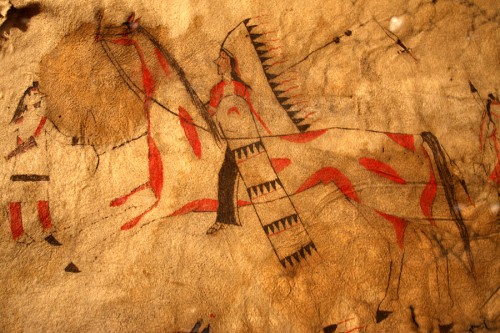Native American spirituality – three myths laid to rest
 In my years of “walking the red road” as well as well as living in the non-Indian world, I’ve come across a few misconceptions about Native American spirituality that I’d like to lay to rest.
In my years of “walking the red road” as well as well as living in the non-Indian world, I’ve come across a few misconceptions about Native American spirituality that I’d like to lay to rest.
Here are the most common misconceptions I’ve heard:
- Native Americans idolize things such as bison [buffalo] skulls and nature.
- Native Americans don’t believe in God.
- Native Americans believe in ghosts.
None of the above is true. Here’s what is true as to what Native Americans believe in:
One: Respecting, appreciating and protecting all life
That includes the natural world and animals. And not just four legged animals, but
two-legged [humans],
wingeds [birds],
swimmers [fish],
creepy crawlers [insects],
the tall standing brothers [trees] and
the green nation [everything else on earth].
While a bison skull may be seen in Native American ceremonies, it is not being worshipped any more than the statues of the saints in a church are worshipped.
Skulls and statues are merely reminders.
The bison skull serves to remind the people that the bison of old was a gift from the Creator which gave Native Americans everything they needed in order to live:
meat to eat;
hides which covered their tipis;
bones which made tools;
sinew was used as thread to make the clothes and coverings;
the extra thick hide on the top of the head became a bowl;
Horns were made into spoons;
The heart was used as an instrument for carrying dried meat;
The stomach became a cooking vessel.
Every part of the bison was used.
This was the reason for the U.S. Government’s campaign to eradicate the bison in the 1800s. Mass slaughter of bison essentially took away the plains Indians’ source of life and, in the words of Gen. Philip Sheridan, “settled the vexed Indian question.”
Prior to the arrival of the Europeans on North America it is estimated there were 50 million bison roaming the western ranges.
By the 1890s they were nearly extinct.
Today the estimate of bison in North America is up to 500,000, thanks to dedicated breeding programs by Native Americans and others.
Two: There is only one God
Borrowing the Rose analogy, God by any other name [Creator, Great Spirit, Higher Power, whatever you want to call him/her] is still the same.
Just because Native peoples call the Great Spirit by a different name than Christians do doesn’t mean it’s not the same God that Christians pray to.
Just because people in Spain speak Spanish and not English doesn’t mean they can’t communicate. A different language is simply a means of communication under another name.
Lack of understanding and respect for other ways of functioning in the world is one of the biggest causes of the tragedies going on today. We all need to learn respect for different ways of seeing the world.
American actor Matt Damon, citing the fact that, as of 2008, only 20% of U.S. citizens had passports, suggested Americans should travel more to better understand global problems. He said, “I think many of our problems as a country would be solved if people had thick passports.”
Fortunately, as of January 2014, the percentage of U.S. passport holders is now up to 46%.
But still, the majority of U.S. citizens have never left the United States.
I find that a shame, as international traveling has broadened my perspective perhaps more than anything else I’ve ever done.
Three: Native Americans do not believe in “ghosts.”
What are ghosts anyway?
A Google search brought up this definition: “an apparition of a dead person that is believed to appear or become manifest to the living, typically as a nebulous image.”
By that definition, Native American do not believe in ghosts.
However, there is an invisible world we cannot see. One that is full of energy, spirits, ancestors . . . and answers.
Some call them spirit guides. Others call them angels. Native Americans might refer to them as ancestors.
Regardless of the name, the world we cannot see is full of life.
I’ll write more about this in next week’s post.
So just because someone does something differently than we do doesn’t make them weird, or wrong.
Seeking to understand the “why” before making judgment is the hallmark of an enlightened person.
And we are all capable of that.
Molly Larkin is the co-author of the international best-seller “The Wind Is My Mother; The Life and Teachings of a Native American Shaman” and other books on health. She is passionate about helping people live life to their fullest potential through her classes, healing practice and blog at www.MollyLarkin.com

